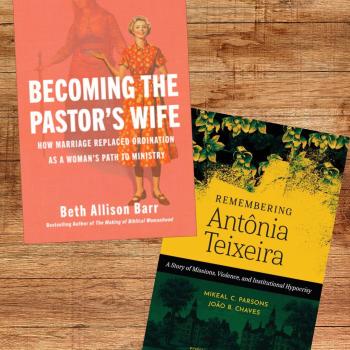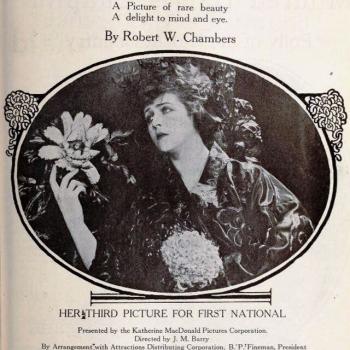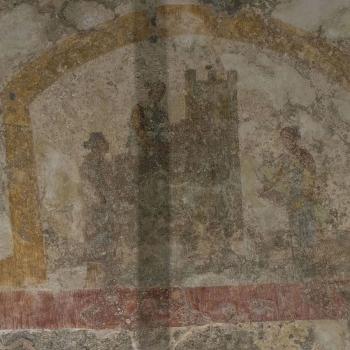In 1998, the Southern Baptist Convention amended the Baptist Faith and Message for the first time since 1963. They voted to add a four-paragraph statement on the family. The new statement declared that a woman should “submit herself graciously” to the leadership of her husband. She “has the God-given responsibility to respect her husband and to serve as his helper in managing the household and nurturing the next generation.” Her husband, in turn, has the “God-given responsibility to provide for, to protect and to lead his family.” Two years later, the Southern Baptist Convention struck again, declaring this time that the pastoral office was closed to women. “While both men and women are gifted for service in the church, the office of pastor is limited to men as qualified by Scripture.”
The uproar was deafening. Especially when, in 2002, the President of the International Mission Board (IMB) of the Southern Baptist Convention Jerry Rankin dropped another bombshell. He sent a message to all current IMB missionaries requesting that they sign a copy of the revised 2000 Baptist Faith and Message. In order to represent the IMB, missionaries had to sign a statement that limited women’s roles in both the family and the church.
I remember when this happened. We had a good family friend who was single and an IMB missionary. I remember how shaken she was by the IMB’s declaration. The hardening of patriarchal attitudes in Baptist churches had shifted from theoretical teachings in Sunday School classes about male headship to tangible actions targeting the lives of real women.
What I find most interesting is how Southern Baptists defended themselves. It wasn’t change, they argued, it was restoration. Al Mohler, for example, argued that female submission was not a “modern idea. “ It was “God’s pattern” as revealed in the literal reading of Scripture.
I think they honestly believe this too. Indeed, I think most people who support male headship and female submission honestly believe this is the “biblical” model. As I argued in my last post, this “biblical” model is based on only a handful of verses that have come only very recently to the foreground of Christianity. The reason we have focused on these verses and interpreted them in particular ways has much more to do with our modern world and much less to do with the Bible itself. Indeed, I think Robert Parham, executive director of the independent Baptist Center for Ethics, summed up well the motivation behind the 1998 SBC statement on women’s roles. “They hope to make June Cleaver the biblical model for motherhood despite numerous biblical references to women who worked outside the home.”
Walter Brueggemann’s warning seems particularly poignant: that “To give any one voice in Scripture the authority to silence other voices surely distorts the text…” Isn’t this what we have done? By defining women’s roles only by a handful of scriptures, haven’t we silenced the rest of scripture? Why does 1 Timothy 2 trump biblical women like Deborah, Huldah, Esther, Rachel, Mary Magdalene, Phoebe, Priscilla, and all the other women working, praying, teaching, and preaching throughout scripture?
Now, I am a pragmatist. I know change is hard. So–if you grew up believing in male headship and female submission, or recently have been converted to this view through listening to Desiring God podcasts or reading Focus on the Family literature or even just attending a strongly complementarian church (like those in the Acts 29 network or an Evangelical Free Church of America)–I am not asking you to change your mind. I just want you to read the other side and at least consider the possibility that female submission is a product of culture rather than something ordained by God.
So here are a few suggestions. I am very grateful to the biblical scholars and historians who helped me compile this list.
Annotated Highlights:
Beverly Roberts Gaventa. Our Mother Saint Paul. Westminster John Knox Press, 2007.
Beverly Roberts Gaventa is a Distinguished Professor of New Testament in the Religion department at Baylor University.
In Our Mother Saint Paul, Gaventa explores the extensive and often unrecognized maternal imagery used by Paul throughout his letters. What I think is especially useful about this text is Gaventa’s argument that “Paul’s theology requires a much larger framework than has usually been thought to be the case.” As we have already seen, Paul’s theology (especially his writings on women) has often been reduced to a handful of verses that seem to focus on the behavior of individuals. Gaventa challenges us to think much more deeply and much more broadly. “The Title, Our Mother Saint Paul, refers to the startling language Paul applies to himself, language of a woman in labor, language of a mother nursing her child. It extends, however, to refer to Paul’s role as a nurture of communities who know themselves to be in the hands of the God who will not leave the world alone, who reclaims the world for God alone.” Indeed, Gaventa’s disclosure of Paul’s maternal imagery easily disrupts John Piper’s claim that “Christianity has a masculine feel.” Rather, as Gaventa shows, the writings of the Apostle Paul give Christianity a perceptibly feminine feel. For those of us who are prone to reduce Paul to specific teachings about women and even (in our current clime) the doctrine of election, Gaventa will help you reframe Paul within the larger context of the gospel story.
Frances Taylor Gench. Encountering God in Tyrannical Texts: Reflections on God, Women, and the Authority of Scripture. Westminster John Knox Press, 2015.
Frances Taylor Gench is the Herbert Worth and Annie H. Jackson Professor of Biblical Interpretation at Union Presbyterian Seminary.
In this deeply thoughtful book, Gench explores the difficult New Testament passages traditionally used to limit women. Contrary to what many have argued about egalitarian readings, Gench demands that we not ignore difficult passages. Instead, we should “read deeper, probe further.” Gench’s insistence that we approach with charity biblical texts and those who read biblical texts differently from us is profound. As she writes, “Collective wrestling with both the text and the interpretations of others is central to the church’s life, a means by which we discern what God is calling us to be and do. So wrestle with all your heart, mind, and strength.” Each chapter walks through a difficult passage, 1 Timothy 2, Ephesians 5, 1 Corinthians 11, 1 Corinthians 14, 1 Timothy 5, and Romans 16. Each also concludes with discussion questions, making this an ideal text for Sunday School classes and small groups.
Craig S. Keener. Paul, Women, and Wives: Marriage and Women’s Ministry in the Letters of Paul. Baker Books, 1992.
Craig S. Keener is the F.M. and Ada Thompson Professor of Biblical Studies at Asbury Theological Seminary.
In this formative text, Keener argues that we must take biblical text seriously, but that also means recognizing the historical context and historical purpose of Paul’s letters. He provocatively argues for us to consider our own modern reasons for rejecting more egalitarian views as well as the larger impact hard-nose patriarchy has on our Christian witness. As he writes, “most people in modern society who do not classify themselves as feminists would nevertheless be offended by an agenda that could suggest women’s social, spiritual, or intellectual inferiority—and rightly so. My guess is that it would have offended Paul, too, especially to find out that his words were being used to advance such an agenda….It is necessary to challenge our culture where it departs from the values of the Kingdom; it is likewise necessary to relate to our culture where it has preserved some of the values of the Kingdom.” Keener divides his chapters into two sections—The Roles of Women in the Church and Women’s Roles in the Family. He also includes two very useful appendices—“Women’s Ministry Elsewhere in Paul” and “Mysteries, Music, Women, and Wine—Ephesians 5:18-21 and the Threat of Subversive Religions.”
Kevin Madigan and Carolyn Osiek, editors and translators. Ordained Women in the Early Church: A Documentary History. The John Hopkins University Press, 2005.
Kevin Madigan is the Winn Professor of Ecclesiastical History at Harvard Divinity School. Carolyn Osiek is the Charles Fischer Catholic Professor of New Testament emerita at Brite Divinity School and the current Archivist for the Society of the Sacred Heart, United States-Canada Province.
Often critics of women in ministry blame the 20th century feminist movement for encouraging women to step outside of their “God-ordained roles.” Yet historians and biblical scholars alike know that women served as church leaders from the very beginning of Christianity. Madigan and Osiek provide all the extant evidence possible for women as deacons and presbyters in the early church (both East and West). They show that female authority existed in early Christian Churches, even as priests and as ordained women exercising liturgical roles. They also demonstrate how culture, even in the early church, influenced attitudes towards women (just as happens today). Because of stricter separation of the sexes and practices secluding women inside their homes, Eastern Christianity made greater allowances for ordained women as it needed women to minister to women. Yet evidence also suggests that more women served as presbyters in the West than in the East. All in all, this sourcebook demonstrates that women served in leadership roles in the early church; it also shows the sparsity of evidence remaining for women in the early church and shows the challenges often facing women. It is an enormously useful text for those unfamiliar with historical sources–especially church orders, inscriptions, letters, biographies, conciliar decrees, etc., and provides a careful description of the texts as well as information for locating the texts. Madigan and Osiek dedicate the book to “the women deacons and presbyters who served in their church communities, and to those who attempt to do likewise today.”
Scot McKnight. The Blue Parakeet: Rethinking How You Read the Bible. Zondervan, 2011.
Scot McKnight is the Julius R. Mantey Chair of New Testament at Northern Seminary.
A dear friend recommended this book to me years ago. Not because she wanted to change my mind, but because she thought it would be refreshing. I was hooked from the preface. Listen to this: “Every one of us adopts the Bible and (at the same time) adapts the Bible to our culture. In less-appreciated terms, I’ll put it this way: Everyone picks and chooses.” McKnight challenges us to think why we focus on certain parts of the Bible and ignore others–why do we silence the blue parakeet? Of particular relevance to this reading list, part 4 focuses on “Women in Church Ministries Today: A Case Study in Rethinking How You Read the Bible.” McKnight walks through his conversion from fundamentalism, explaining concepts such as “soft patriarchy,” “hard patriarchy,” and “mutuality.” He also struggles with the difficult Pauline texts about women, reframing Paul both historically within the first century and contextually within scripture. He concludes that in the Bible “women did lead and women did teach.”
Further Readings
Beverly Roberts Gaventa. When in Romans: An Invitation to Linger with the Gospel According to Paul. Baker Academic, 2016.
Annette Bourland Huizenga. Wisdom Commentary 1-2 Timothy Titus. Michael Glazier, 2016.
Carol A. Newsom, et. al. Women’s Bible Commentary: Revised and Updated. Westminster John Knox Press; Revised, Updated edition, 2012.
Ruth Tucker. Women in the Maze: Questions and Answers on Biblical Equality. Downers Grove, IL: Intervarsity Press, 1992.
How I Changed My Mind about Women in Leadership: Compelling Stories from Prominent Evangelicals. Zondervan, 2010.
Audra and Joe Trull. Putting Women in Their Place: Moving Beyond Gender Stereotypes in Church and Home. Smyth & Helwys, 2003.
Bruce M. Winter. Roman Wives, Roman Widows: The Appearance of New Women and the Pauline Communities. Eerdmans, 2003.
Happy Reading!













